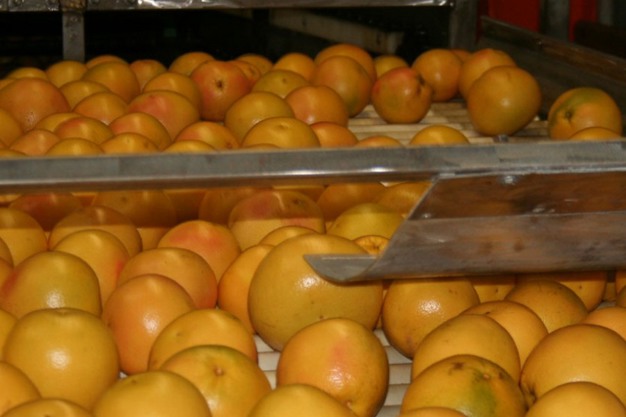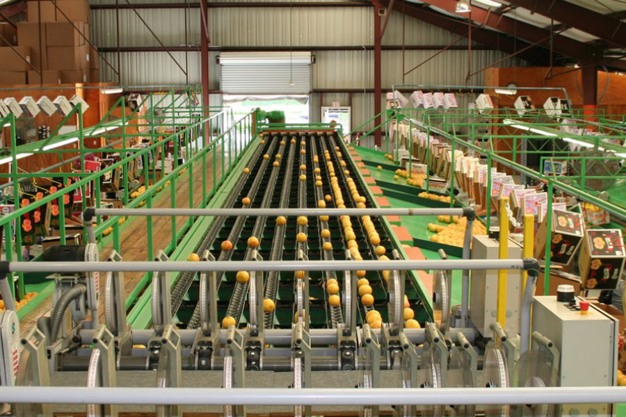With plans to start harvest in the middle of October, the outlook on the Florida grapefruit season is optimistic. "The crop looks good," says Dan Richey of Riverfront Packing Company.
It is almost a tale of two crops, so to speak. "The older trees are declining because they're older, they've been subject to citrus canker and citrus greening," he says. "They would have been in decline anyway without those diseases because of their age. However, the disease proliferation accelerated their decline."
In turn, those trees have less volume and the fruit can typically be smaller because the tree is stressed.
Newer, younger production
Meanwhile, the younger trees are thriving thanks to new therapies protecting them from greening particularly. "The trees that are three to five years old have a good crop load. The sizing and quality are good. So we're optimistic about where we're heading with these younger trees, though we still have to get through the bottom of the bell curve in supply," says Richey.

To protect the newer generation of trees from infection, two types of therapies are being applied: employing nets on top of the trees until they're about two to three years old to let the trees get a good start. Or, what Riverfront Packing is doing is applying kaolin clay to the trees. That clay puts a red coating on the leaves and the (Asian citrus) psyllid that has historically spread citrus greening can't see that color. (Or if they do, they're quickly deterred.)
There is also citrus under protective screening (CUPS) growing in more than 1,000 acres in Florida. This high-density growing is akin to growing grapefruit in greenhouses which fully prevents infection given the psyllid can't get in under the screening. In the next two to three years, it's estimated that growing this way will produce well over 1 million boxes.
Prevention as well
However, there are also preventative therapies to contend with possible infection. "After taking the nets off, we use an antibiotic therapy that's injected into the trees to get to the bacteria," Richey says, adding that the company is in its third year of injections. "We've tried multiple ways to get to the bacteria–spraying, putting it in the roots and none of that has worked like the injections. So we're seeing a real increase in vitality in the trees after injection."

All of this is being done with the belief that there will be growth again in Florida's grapefruit production. "A large segment of our industry is shifting to grapefruit right now as far as new plantings. That's a real plus. We will never get back to 60 million boxes," he says. "We're currently at 1.7 million boxes and I can see us getting to eventually 4 million boxes which would put us on par with Texas."
More immediately, this year's crop will be similar to last year's given the crossover between moving away from the older trees and turning to the more protected newer trees. "It won't be a hockey stick type of incline. It's more of a slow crawl out but I think we're at the bottom of the bell curve. We may see one more year of a slight decrease but then with CUPS, and the volume of young trees that have been planted, their production will begin to surpass what we're removing in the next year or so," says Richey.
As for demand this season, it's anticipated to be good. Historically, Florida grapefruit has been 50 percent export/50 percent domestic demand and that has also changed. Today, distribution is leaning towards the domestic market. "That's due to impediments in the export market," says Richey. Those include factors such as maximum residue levels (MRLs) implemented in Europe, Korea, and to a lesser extent, Japan. That means it's more expensive now to grow fruit for export in adhering to MRLs.
European challenges
There's also the belief that the European Union has become more protectionist around citrus. "They are the only region in the world that does not accept the fact that fruit is not a pathway for spreading diseases like black spot and citrus canker. There are draconian restrictions on us–it has to be completely spec-free and that's an issue. If there's a spec of canker the size of a pencil point, you have to re-export that entire container and there's no place to re-export to. You have to turn it around and ship it back to the U.S. We have citrus canker here but we don't have citrus black spot in the grapefruit region–that's a big issue for Argentina and lemons and South African grapefruit and oranges," Richey says.
Shipping routes to Asia have also shifted and congestion issues in places like the Panama Canal add to the logistics issues and significantly extend shipping time. Alternatively, fruit is trucked to the West Coast and shipped out of ports such as Oakland–though of course that increases shipping costs.

In exports, there has also been an influx of grapefruit from other regions such as Israel, Turkey, and Mexico, all of which have come in at lower costs and absorbed market share that once belonged to Florida. "Even though we have a superior product everybody recognizes, the delta between their price and our price has gotten too great for us to grow those markets now," says Richey.
Mexico and grapefruit
It's also further complicated by issues around Mexican fruit including the longstanding rule about the fruit meeting Florida standards. However, Florida growers say there's been a side agreement that has allowed Mexican fruit into the U.S. that is not meeting the state's specifications. "Now you have twice as much fruit coming into the U.S. from Mexico and it's much lower quality due to the allowance of much lower juice content in Mexican imported grapefruit," he says. "We're concerned that's having a negative halo effect with consumers. They might be buying fruit not knowing where it's coming from with thick skin and a low juice content and they don't repeat buy."
Exporting Florida grapefruit hasn't been eliminated though. Riverfront will still maintain its exports though growing those markets is, for now, on hold. (In fact, this year the company will export its first CUPS-grown fruit.)
So with the regrowth in the Florida industry, growers know that its high pricing could be a challenge. Part of that stronger pricing is because yield per acre--because of greening--has shifted to 200 boxes/acre from 500-600 boxes/acre. "To survive, we have a price point that is a bit challenging compared to other lower-cost providers of grapefruit," says Richey. This season's pricing is expected to be the same, if not slightly increased, compared to last season, due to inflation on costs.
 For more information:
For more information:
Dan Richey
Riverfront Packing Company
Tel: +1 (772) 562-4124
www.scottcitrus.com










